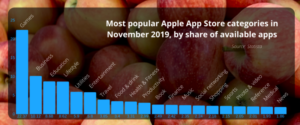Heart, lungs, liver, spleen, [gadget]. It seems the list of vital human organs has increased by that last one, as people are growing inseparable from their Internet connections. The legendary “average adult in the U.S.” now spends about 3 hours 45 minutes a day on a mobile device, and among other results, mobile apps are a huge thing now. In the first half of 2019, $39.7 billion revenue was raised on apps. The possibilities for businesses that decide to launch one are immense, starting from messaging and feedback opportunities to fostering loyalty and collecting customer insights, not to mention paid services. However, the competition is nightmarish. The 2.47 mln Android apps on Google Play + the 1.8 mln iOS on Apple Store can’t all be leaders. Besides, 79% users “churn” (i.e. stop using the app) on the next day after they’ve downloaded it. Being competitive here is about generating really cool mobile app ideas in the first place.
Each year, the mobile enthusiast/geek/business analysis community throws lists of new application ideas. Some of these stick, some don’t. But what if you want to be able to create ideas of your own? After all, no one knows your business, your current niche and your New Year resolutions better than you. Here is what marketers, UX’ers and developers have to say on the matter (and some examples, as well).

(Definitely not the ways to think about it)
In the quest to create a perfect, hit & lit, trending mobile app, many decision makers have failed horribly. At first sight, the app idea seemed good enough; after all, that’s what had made their competitors thrive in the previous quarter, so why on Earth? Here are the three common traps to avoid:
“Let’s just benefit from that trend millennials like.”2018-2019 have seen a fair share of AR apps that offered nothing except the AR itself – and this is just one example. Another would be the quite uninspired attempts at eLearning “gamification” – that could not tear the crown off the recognized leaders. The truth is, one should never think of trends as of the ultimate content/idea of an app. They are the means to an end, not the end itself.“Our nemesis Company X made such an app, now we should too.”This is why the app stores have so many apps: you didn’t expect them all to be unique, right? There are 2 possible scenarios when “mimicking” an app is justified: (a) customers now expect the same thing from you; (b) you have something to add to the initial idea, making it even better.“Personally I like that thing, so my customers will appreciate it.”It’s all too easy to fall for the personal preferences over what the actual market research says. In some cases, there are visionary glimpses, but it’s better to study the target audience, first. Just to be on the safe side.
Hopefully these CAUTION disclaimers did not overwhelm you – because now that they’re out of the way, let’s study the good things. Inspiration and its inner workings, and so on.
The Physics of inspiration, or What makes for good mobile app ideas
Developers don’t make apps great, they enable the customers to do so. Ultimately, it’s the target audience who gets to decide how good the app is, and whether they will use it. Here’s where psychology matters much. Why do people like an app, or want one?
- The app solves a problem they don’t know how to tackle otherwise. Take Airbnb, for example, with its >6 mln listings around the world. These days, not everyone is lucky enough to dedicate time to booking their accommodation (or offer spare rooms) while sitting comfortably at their desktop in search for options. Urgent trips, spontaneous vacation decisions, deadlines that eat away the personal to-do list… The app solved the problem and got its deserved popularity.
- The app gives its users superpowers (which are fun). What has been the officially recognized best iPhone app in 2019? A thing called Spectre Camera, which basically allows to take “long-exposure” photos (a highly Instagrammable thing, by the way). Until recently, this sort of pictures required a photographer’s skill and patience. Now, though, the user suddenly got the power. If you think about it, that’s also why VR apps are a thing.

- The app is simply, inherently, neurologically fun. Humans are hardwired to view certain activities as fun. Some of these are linked with the need to relax and tackle easy tasks instead of the real, complex ones. Some are the instinct to practice simple skills. Think of:
- a cat playing with a butterfly, or
- a human playing a simple, 80’s style gameboy on a smartphone, or
- using Duolingo instead of going to a classroom to learn a language.
This “addictive” factor is sometimes giving people the comfort they need. The same thing goes for collecting items, matching things or suddenly seeing/imagining familiar objects in a completely new light. Does that lawn have a Pokemon on it?
- It makes something faster or more convenient. A food ordering app called GrubHub currently boasts about 19.3 mln active users. Reason? Ordering food delivery from a single app is kind of quicker than browsing through a number of websites. Oh, and besides, they managed to cover the smaller towns that did not have that perk before them.
- It gives the sense of being in the community. We are social creatures. Social media apps are just the most superficial example of how the possibility to be part of a community makes an app a must-have. After all, social media are not just about communication in chats or messengers – it’s about self-identification, comparing yourself to others, being part of this group and not that one. For example, this is why eLearning apps now almost universally feature leaderboards, forums and communities.
Now here’s a game. Let’s list these 5 factors vertically, and horizontally… Just come up with whatever aspects of life matter to you or your business. A table like this will appear:
| Finance | Health | Food | Places | Routines | Anything else | |
| Solves a problem | ||||||
| Superpowers | ||||||
| Simply fun | ||||||
| Convenience | ||||||
| Community |
Half of the cells will be empty forever, but the other half can contain valuable and simple app ideas. The intersection of “health” and “community”, for example, could yield the possibility for an app connecting people who:
- exchange health tips,
- debunk myths based on each other’s experience,
- rate tips, or
- track their performance.
Then try to identify the core feature and imagine a minimum viable product with just that one. What you, as a user, would like to add to it? Then ask at least a dozen other people to refine the idea.

Of course, this works better if you actually have a notion of what the customers want from the app, based on market research – and then use this sort of method to provide the identity for the app. And of course, no one says things can’t be combined!
9 practical examples of ideas for apps
Let’s explore what kind of concepts one could get following the approach. Some of these are already “in the air”, some not. Also, while thinking of any concept, it’s a good idea to try and apply it to a different area of activity or a different market sector. An app idea designed for, say, cooking fans, could be reworked to create something similar for car enthusiasts or computer game geeks – only when a reasonable amount of insight into the target audience is taken into account.
Lifehack ranker
A community-based app that allows users to post lifehacks and categorize them into topics, picking keywords (repair, shopping, workplace relationships, etc.) – as well as rate or comment on the existing ones posted by others. The top rated lifehacks are displayed first as the results of a search query. A further enhancement would be the possibility to search for tips via voice interface. The users can form “expert groups” based on their area of interest and earn status for active use. Local groups (e.g. for a specific town’s infrastructure) could be formed around questions like “Where do I get an old thermometer recycled in [area]?” For business, this would allow to collect insights about the potential customers, as well as display ads.
AR-based interior design visualizer
An idea that several experts have voiced over the past months, this is a niche that clearly waits for its providers. The idea is that the user can visualize pieces of furniture or decor of a selected category by directing the device on the available spot, saving time for browsing the web for variants. The app pulls suggestions based on the available offers from online marketplaces/stores based on the dimensions and displays prices. The benefit for businesses is a type of product placement ads that the users themselves would like to see.
Meme-i-fier
For those who like memes, this could be an app that makes instant photos, recognizes faces and automatically photoshops them into a meme or any other image. The app could also accept 1-2-word hints from the user as text, e.g. “Friday night”. The resulting pictures can be remade with a different picture by tapping “redo” or immediately shared online. For the user, this is just a quick anti-stress humor app (“haha, that’s Joe on a Friday night, dressed as a lobster”). For the company, this – again – provides possibilities to upload product-themed images to be shared online.
Another thing that a number of experts in the app development community are considering: a platform that unifies all the feeds from all the user-selected social media networks. Instead of having to log into each one individually or switch between them, the user gets a holistic view of what’s going on in the universe of their friends and colleagues.

Gift finder
It can be tough to find the perfect gift for a person you appreciate (or not so much, in which case things may get harder still). Instead of running about stores packed with pre-holiday shoppers or searching the web, page by page, the user can find a pre-filtered list of options. This list can be arranged by the app using the public data from that person’s social media accounts, as well as applying algorithms that are currently used in marketing (segment, age group, and other demographic data taken into account). The data for targeting can be partly provided by businesses that wish to promote their products via the app. As additional features, the app may exhibit interface for actually ordering the gift, and even a feedback that the app may use to rank the search results for other users with similar queries.
Message classifier
An email spam filter on steroids, this app, if provided access to messengers and/or email, can analyze the incoming messages and sort them into categories, possibly storing them on cloud for future retrieving. Many office workers actually use a similar feature in their email clients, sorting mail into folders, so why not make it automated?
What do you call it? (language app)
Most people who have good knowledge of a foreign language often are quite proficient in a limited number of topics, but there are those short humiliating moments when you still need to say “that thing, you know” – for example, because you can’t remember the Spanish word for “colander”. As of now, ML allows for object recognition, which can give rise to a useful app. Direct your device on the unnamable object and the app will come up with possible variants for translation. If the users are allowed to rate the translations, the app can learn further. FInally, it can incorporate a simple flashcard functionality to help memorize the words.

Cheaper/more glamorous equivalent finder
Have you ever looked at some product and thought: it’s too expensive because of the brand / additional features / design / whatever, but I’d rather go for a more “basic” option? Or vice versa, considered some item attractive but clearly too low-level and cheap? An app could recognize consumer goods or foods and then connect to online stores to find cheaper or more “prestigious” variants of that product.
A similar idea could be used for food: analyzing the ingredients of a scanned and recognized product and finding a combination of foods to offer the same nutrients or flavors.
Song of the day
An app integrated with online music platforms like Soundcloud that receives verbal information as input and suggests a playlist based on this day’s concern. For example, if the user is going to a job interview, it can offer songs on topics of confidence, winning the day, etc. If the app is further enhanced with voice recognition, it can be used in a company or even a party to offer highly personalized playlists. The business, in turn, receives a possibility of promoting certain content.
Stress source identifier
There already are mobile apps that can measure things like heart rate and body temperature. These, and several other indicators can be used to tell when the user is feeling stressed out. This means that an app can be built to help its users identify the possible sources of stress and compare just how much of an annoyance they really are. Is that the noise behind the window? The humming of a fridge? A certain scent? Further on, there may be the possibility to create communities of users who find ways to reduce stress in similar situations together.
Technologies available: recap
It is, as mentioned above, a terrible idea to start an app concept around a particular tech trend or new feature. On the other hand, keeping the technical possibilities in mind is a must – if only because otherwise you would end up thinking of apps from several years ago and try to emulate them.
What technologies are now empowering the most breathtaking ambitions? Let’s recap, and also think of their benefits and limitations:
- Virtual or Augmented Reality. These are, in fact, very different in practical implementation. VR required equipment, and though it’s now not as expensive as it used to be, no one carries it with them all the time. The whole point of a mobile app, though, is that it’s always with the user. In this light, AR becomes the most viable alternative. It serves well for providing “superpowers”, which is one of those success points for apps – and is becoming cost-efficient enough.
- AI and Machine Learning. Thanks to these, apps are becoming truly smart, and can now perform tasks that we could only dream of yesterday, like sorting emails or searching for gift ideas for us. The drawback, for now, is that the technology can still be error-prone, and sometimes noticeably so. The financial side usually encourages taking ready solutions and incorporating them into your app, but hey! Building from scratch has not been the only option for a long time now.
- APIs to widely used platforms, including social media, online stores and booking services, etc. Allow to draw on a huge pool of data with the user’s consent, so that the app can now not just “do its own thing” (like return a result of processed data) but also take a further step. Found a hotel? Book it straight away!
- Geolocation. Most important for apps in the convenience category, although sometimes presenting difficulties with privacy concerns. This should be thought through at the planning stage.
- Voice. Siri and Alexa are no longer alone, as there emerge possibilities to ember voice functionality into custom apps.
- Cross-platform frameworks and toolkits. Allow to build apps really fast without distinguishing between “Android app ideas” and “iOS app ideas”. For businesses, this means quicker time-to-market and reduced cost of development; customers get a consistent user experience across platforms and better performance. As of now, React Native is among the best choices, with its modular approach, pre-built components, and less use of memory. React Native is used by Skype, UberEats and Instagram. Another option is Flutter, which is useful when the time for development is scarce, and also when the app needs to rely on OS-level capacities.

Final considerations
Even the cool app ideas can become useless if they are implemented inefficiently. Creating a potentially brilliant app that users are dissatisfied with is actually a great service to the competitor. The app concept becomes known, the audience are starting to search for “that sort of app” and waiting for someone to snatch the idea and build exactly the thing. The light bulb was invented before Edison; he became famous because he was the first one with a usable light bulb.
Where to look to make sure your valuable idea grows to full blossom and starts bearing fruit? Here are some key considerations:
- User experience is crucial. It has been claimed that every $1 invested in UX yields a return between $2 and $100. Is your app about to do complex tasks? Make running the app simple for the user, with a minimum of taps required, good, consistent GUI and generally well-thought of user stories.
- Performance and speed may be boring things to think of, but without them, the app itself becomes boring. By the way, this is why frameworks like React Native become popular – they make life easier for the developer, but do not sacrifice the comfort of the user.
- What is the next step for the user? This is something already mentioned above, but can’t be overestimated: suppose the app has performed some action for the user. Now what? Close it? Do the next logical thing without the app? After each interaction with the app, it should suggest the user to do something next, be it make a booking, order, rate something, provide instant feedback, get more information, and so on – unambiguously.
The best thing about mobile apps is that they are so close to the user, literally seconds away from interacting with them. To deserve that privileged place, an app should be really special – and you are capable of providing the idea for exactly the one that your business will benefit from! Once your core concept is in place, don’t let it stay in the realm of dreams: have it implemented by an experienced team, who can not only make sure that the essentials are okay, but also provide valuable insights from the technical and UX point of view.
